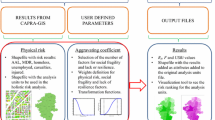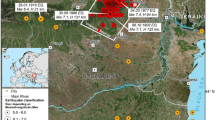Abstract
The Disruption Index is used here for the assessment of urban disruption in the Mt. Etna area after a natural disaster. The first element of the procedure is the definition of the seismic input, which is based on information about the historical seismicity and seismogenic faults. The second element is the computation of the seismic impact on the building stock and infrastructure in the region considered. Information on urban-scale vulnerability was collected and a geographic information system was used to organize the data relating to buildings and network systems (e.g., typologies, schools, strategic structures, lifelines). The central idea underlying the definition of the Disruption Index is the identification and evaluation of the impacts on a target community, considering the physical elements that contribute most to the severe disruption. The results of this study are therefore very useful for earthquake preparedness planning and for the development of strategies to minimize the risks from earthquakes. This study is a product of the European “Urban Disaster Prevention Strategies using Macroseismic Fields and Fault Sources” project (UPStrat-MAFA European project 2013).
Access provided by Autonomous University of Puebla. Download conference paper PDF
Similar content being viewed by others
Keywords
1 Introduction
Natural disasters, such as earthquakes and volcanic eruptions, have strong effects on the socio-economic well-being of countries and their people. The consequences of these events can lead to complex cascades of related incidents, and in more serious contexts they can threaten our basic survivability. These events have clearly demonstrated that preparedness and disaster management is a dynamic process that requires a holistic analysis of critical interdependencies among core infrastructures. In this context of complexity, uncertainty and doubt, the Disruption Index (DI) (Ferreira 2012; Oliveira et al. 2012; Ferreira et al. 2013) aims to improve our understanding of earthquake and volcanic hazards and their impacts in urban areas. The development of the DI, which involved defining the elements that provide a clear picture of a functional urban system and the various ways in which disruption can occur, was carried out using information and experience gained through several earthquake field missions in different regions of the world, including the Azores (Oliveira et al. 2012; Ferreira 2012; Ferriera et al. 2012).
2 Seismic Context of the Volcanic Region of Mt. Etna
In the volcanic region of Mt. Etna, the highest epicentral intensities that have reached degree IX on the European Macroseismic Scale (EMS) have been concentrated in the very populated areas between Acireale, Zafferana and Giarre, the main towns on the eastern flank of Mt. Etna. In contrast, the Piedmont areas of the Mt. Etna volcano and the metropolitan area of Catania have never been affected by significant macroseismic effects (Azzaro et al. 2013). Another feature of this seismicity of Mt. Etna is that the attenuation of the macroseismic intensity with distance is much greater than in tectonic zones. In recent years, the modeling of the attenuation at Mt. Etna has also been tackled through Bayesian probabilistic approaches, which aim to obtain seismic damage scenarios that are expressed in terms of the macroseismic intensity. This approach has also examined the role of a linear source in the attenuation pattern, which determines the preferential propagation of the intensity along the fault strike, and the rapid decrease in the effects in the perpendicular direction. The calculation procedure is implemented in the PROSCEN software; given the location and the epicentral intensity of the earthquake, the code generates the expected seismic scenario, according to the assumption that there is a point seismic source or a linear seismic source (finite fault).
3 The Concept of the Disruption Index of Livelihood Systems
The destruction or unavailability of some basic urban functions for a long period of time will impact upon the dimensions of human need, such as the environment, housing, health, education, employment, and food processing and distribution. These main dimensions are organized and they are conditioned by several other main functions or systems, including water, sanitation, telecommunication, electricity, security, and mobility. These are, in turn, dependent on the reliability of various buildings, equipment and crucial facilities (Fig. 71.1, pink boxes), which need to be obtained from earthquake simulators or earthquake descriptions (i.e., field reports).
Vital urban functions and their dependencies (Ferreira 2012)
The purpose of the DI is to quantify how several elements of influence and urban functions become highly relevant in the exacerbation of the impact of an event. It is possible to associate qualitative impacts with each dimension, using a scale that describes all of the plausible impacts that might be present, as objectively as possible (Ferreira et al. 2013). The network of the dependencies is complex; disruption of one of the functions might affect one or more of the above-mentioned general areas, and a function can depend, in its turn, on other functions. All functions depend on the equipment and facilities, which are the physical structures that can be damaged by earthquakes.
A few examples can help us to understand the variety and complexity of the dependencies. Disruption of the water supply can derive from direct damage to the water equipment (e.g., pumps, valves, piping, tanks) and/or from disruption of the electricity supply, which, in turn, can be caused by damage to the electrical equipment. Disruption of the electricity supply affects not only the water supply, but also telecommunications and transport systems, and directly or indirectly, almost all of the general areas of human needs. The network of these dependencies is illustrated in Fig. 71.1. For the evaluation of the DI, the key elements are the characterization of the earthquake impact in terms of the severity levels from I to V (where I denotes minimal impact), and the modeling of the propagation of the impact severity. Each severity level corresponds to a description of the earthquake impact. For transportation infrastructure, for example, level II indicates moderate damage to roads, railways, airports, and ports, while for the power supply, it means recovery within hours.
Impact severity propagation is calculated as a bottom-up sequence, which starts from the physical damage suffered directly from the exposed assets. The impact severity on each function and area of human needs derives from the impact severity on the infrastructure, facilities and functions on which these needs depend, while the level of the DI depends on the impact severity across all of the areas of human needs. Each calculation is driven by a chain of conditions that are linked by the logical function OR and are based on the idea that the severity level that results from the chain is equal to the worst severity level along the chain itself. The impact level on the water supply, for example, is III if it is III for the water equipment or the electricity supply, upon which the water supply depends. The same idea applies to the calculation of the DI level. Therefore, if one of the general areas of the human dimension suffers the highest level of disruption, the DI reaches its maximum.
4 First Results of Application of the Disruption Index to the Mt. Etna Area
The DI is here applied to the May 8, 1914, Mt. Etna earthquake. Figure 71.2 (left) shows the damage scenario in terms of the intensity (EMS) estimated through the PROSCEN software package (Azzaro et al. 2013). The damage data used to compute the DI in this first application refers to residential buildings, hospitals, schools, police stations, lifeline services (electricity, water, gas, wastewater) and roads. The data about the buildings were extracted from the 1991 and 2001 Italian National Institute of Statistics (ISTAT) census. The data are grouped according to the census sections, and the vulnerability indices were evaluated using the approach proposed by Lagomarsino and Giovinazzi (2006). The ISTAT data on residential buildings allows the definition of the frequencies of groups of homogenous structures, with respect to a number of typological parameters: vertical structures, age of construction, number of storeys, state of maintenance, and state of aggregation with adjacent buildings. We applied this information only to the urbanized areas of the whole of the territory of the municipality. We use also the socially useful work (lavori socialmente utili; LSU) database (Cherubini et al. 1999).
Regarding the lifelines, we considered the main lines. High voltage power lines and their related pylons were mapped into the geographic information system, together with the positions of high and low voltage substations. For roads, a dense network of roads connects the villages, and the Messina-Catania main road runs along the coast on the eastern flank of the Mt. Etna volcano. Moreover, a dense network of roads connects the villages, and within this network we have considered the positions and the seismic vulnerabilities of the bridges, which are the most sensitive elements. Figure 71.2 (right) shows the resulting pattern of the DI. The description of the DI that was adopted is given in Fig. 71.3.
References
Azzaro R, D’Amico S, Rotondi R, Tuvè T, Zonno G (2013) Fore-casting seismic scenarios on Etna volcano (Italy) through probabilistic intensity at-tenuation models: a Bayesian approach. J Volcanol Geoth Res 251:149–157
Cherubini A, Corazza L, Di Pasquale G, Dolce M, Martinelli A, Petrini V (1999) Risultati del progetto LSU-1. In: Censimento di vulnerabilità degli edifici pubblici, strategici e speciali nelle regioni Abruzzo, Basilicata, Calabria, Campania, Molise, Puglia e Sicilia. Graphic Press s.r.l., L’Aquila
Ferreira MA (2012) Risco sísmico em sistemas urbanos. Ph.D. Thesis. Instituto Superior Técnico, Universidade Técnica de Lisboa, p 295 (in Portuguese)
Ferreira MA, Mota de Sá F, Oliveira CS (2012) DI: the concept of disruption index in urban systems. In: Proceedings of 15th world conference on earthquake en-gineering, Lisbon, 24/28 Sept 2012
Ferreira MA, Mota de Sá F, Oliveira CS (2013) Disruption index, DI: an approach for assessing seismic risk in urban systems (theoretical aspects). Bull Earthquake Eng 11:543–559
Lagomarsino S, Giovinazzi S (2006) Macroseismic and mechanical models for the vulnerability and damage assessment of current buildings. Bull Earthquake Eng 4:415–443
Oliveira CS, Ferreira MA, de Mota Sá F (2012) The concept of a disruption index: application to the overall impact of the July 9, 1998 Faial earthquake (Azores islands). Bull Earthquake Eng 10:7–25
UPStrat-MAFA European project (2013) http://upstrat-mafa.ov.ingv.it/UPStrat/
Acknowledgments
This study was co-financed by the EU—Civil Protection Financial Instrument, in the framework the European project “Urban disaster Prevention Strategies using MAcroseismic Fields and FAult Sources” (Acronym: UPStrat-MAFA, Grant Agreement N. 23031/2011/613486/SUB/A5).
Author information
Authors and Affiliations
Corresponding author
Editor information
Editors and Affiliations
Rights and permissions
Copyright information
© 2015 Springer International Publishing Switzerland
About this paper
Cite this paper
Zonno, G. et al. (2015). Applying the Disruption Index Procedure to Evaluate the Urban Seismic Risk in the Mt. Etna Area (Italy). In: Lollino, G., Manconi, A., Guzzetti, F., Culshaw, M., Bobrowsky, P., Luino, F. (eds) Engineering Geology for Society and Territory - Volume 5. Springer, Cham. https://doi.org/10.1007/978-3-319-09048-1_71
Download citation
DOI: https://doi.org/10.1007/978-3-319-09048-1_71
Published:
Publisher Name: Springer, Cham
Print ISBN: 978-3-319-09047-4
Online ISBN: 978-3-319-09048-1
eBook Packages: Earth and Environmental ScienceEarth and Environmental Science (R0)







